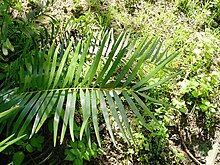User:Hsp.miller/sandbox
Gymnosperm
Initial thoughts on how to improve article:
- Many sentences would be difficult to understand for someone not studying plant biology.
- Simplification of the article is needed. Many of the sentences need to be reworded for clarification and
- Need to edit the hyperlinks as some are mentioned more than once/the hyperlink is placed after the word is used the first time. (I need to review rules for this.)
- More pictures would be great as the article is rather bland to look at currently.
(picture for the beginning of the article replaced)
The gymnosperms are a group of seed-producing plants (
The gymnosperms and
By far the largest group of living gymnosperms are the conifers (pines, cypresses, and relatives), followed by
Classification
In early classification schemes, the gymnosperms (Gymnospermae) were regarded as a "natural" group. There is conflicting evidence on the question of whether the living gymnosperms form a
For the most recent classification on extant gymnosperms see Christenhusz et al. (2011). There are 12 families, 83 known genera with a total of ca 1080 known species.
Subclass Cycadidae
- Order Cycadales
- Family Cycadaceae: Cycas
- Family Zamiaceae: Dioon, Bowenia, Macrozamia, Lepidozamia, Encephalartos, Stangeria, Ceratozamia, Microcycas, Zamia.
- Family
Subclass Ginkgoidae
- Order Ginkgoales
- Family Ginkgoaceae: Ginkgo
Subclass
- Order Welwitschiales
- Family Welwitschiaceae: Welwitschia
- Order Gnetales
- Family Gnetaceae: Gnetum
- Family
- Order Ephedrales
- Family Ephedraceae: Ephedra
Subclass Pinidae
- Order Pinales
- Family Pinaceae: Cedrus, Pinus, Cathaya, Picea, Pseudotsuga, Larix, Pseudolarix, Tsuga, Nothotsuga, Keteleeria, Abies
- Order Araucariales
- Family Araucariaceae: Araucaria, Wollemia, Agathis
- Family Podocarpaceae: Phyllocladus, Lepidothamnus, Prumnopitys, Sundacarpus, Halocarpus, Parasitaxus, Lagarostrobos, Manoao, Saxegothaea, Microcachrys, Pherosphaera, Acmopyle, Dacrycarpus, Dacrydium, Falcatifolium, Retrophyllum, Nageia, Afrocarpus, Podocarpus
- Order Cupressales
- Family Sciadopityaceae: Sciadopitys
- Family Cupressaceae: Cunninghamia, Taiwania, Athrotaxis, Metasequoia, Sequoia, Sequoiadendron, Cryptomeria, Glyptostrobus, Taxodium, Papuacedrus, Austrocedrus, Libocedrus, Pilgerodendron, Widdringtonia, Diselma, Fitzroya, Callitris (incl. Actinostrobus and Neocallitropsis), Thujopsis, Thuja, Fokienia, Chamaecyparis, Callitropsis, Cupressus, Juniperus, Xanthocyparis, Calocedrus, Tetraclinis, Platycladus, Microbiota
- Family Taxaceae: Austrotaxus, Pseudotaxus, Taxus, Cephalotaxus, Amentotaxus, Torreya
Diversity and origin
There are more than 1000
It is widely accepted that the gymnosperms originated in the late
Conifers are by far the most abundant extant group of gymnosperms with six to eight families, with a total of 65-70 genera and 600-630 species (696 accepted names). Conifers are woody plants and most are evergreens. The leaves of many conifers are long, thin and needle-like, other species, including most Cupressaceae and some Podocarpaceae, have flat, triangular scale-like leaves. Agathis in Araucariaceae and Nageia in Podocarpaceae have broad, flat strap-shaped leaves.
Cycads are the next most abundant group of gymnosperms, with two or three families, 11 genera, and approximately 338 species. A majority of cycads are native to tropical climates and are most abundantly found in regions near the equator.

The other extant groups are the 95-100 species of Gnetales and one species of Ginkgo.
(moved picture from intro, will get different picture for intro)
Uses
Gymnosperms have major economic uses. Pine, fir, spruce, and cedar are all examples of conifers that are used for lumber, paper production, and resin. Some other common uses for gymnosperms are soap, varnish, nail polish, food, gum, and perfumes.
Life cycle
(added picture of life cycle of gymnosperms)
Genetics
The first published sequenced genome for any gymnosperm was the genome of Picea abies in 2013.
Heterospory Reviewing
Is each fact referenced with an appropriate, reliable reference?
- Each section and paragraph seem to be well cited with at least one source per paragraph.
- I did not find any facts that appeared to need a source, nor did I find any sections that had a [citation needed]
Is everything in the article relevant to the article topic? Is there anything that distracted you?
- Everything appears to be very relevant and describes the topic well.
Is the article neutral? Are there any claims, or frames, that appear heavily biased toward a particular position?
- The article is neutral, and when there is a specific model mentioned (the Haig-Westoby model, for example), it is referenced and mentioned
Where does the information come from? Are these neutral sources? If biased, is that bias noted?
- The information comes from a variety of sources, such as books and various scientific articles
- The sources are appropriate and none of them seem to be unofficial or biased
Is any information out of date? Is anything missing that could be added?
- The information from the sources comes from sources dating from 1989-2017; however, the information from the older sources appears to be relevant and still correct
Check the talk page. What kinds of discussion is going on in the Wikipedia community about how to represent this topic?
- There's only one comment on the talk page and it's about correcting the wording of something that is not considered a fact
My general thoughts about the article:
- There appears to be quite a bit of complicated wording that someone not well versed in plant biology would be confused. Perhaps provide short, basic descriptions of some words that are used often in the article?
- Seems to be a good article the covers the topic well
 | This is a user sandbox of Hsp.miller. You can use it for testing or practicing edits. This is not the sandbox where you should draft your assigned article for a dashboard.wikiedu.org course. To find the right sandbox for your assignment, visit your Dashboard course page and follow the Sandbox Draft link for your assigned article in the My Articles section. |
